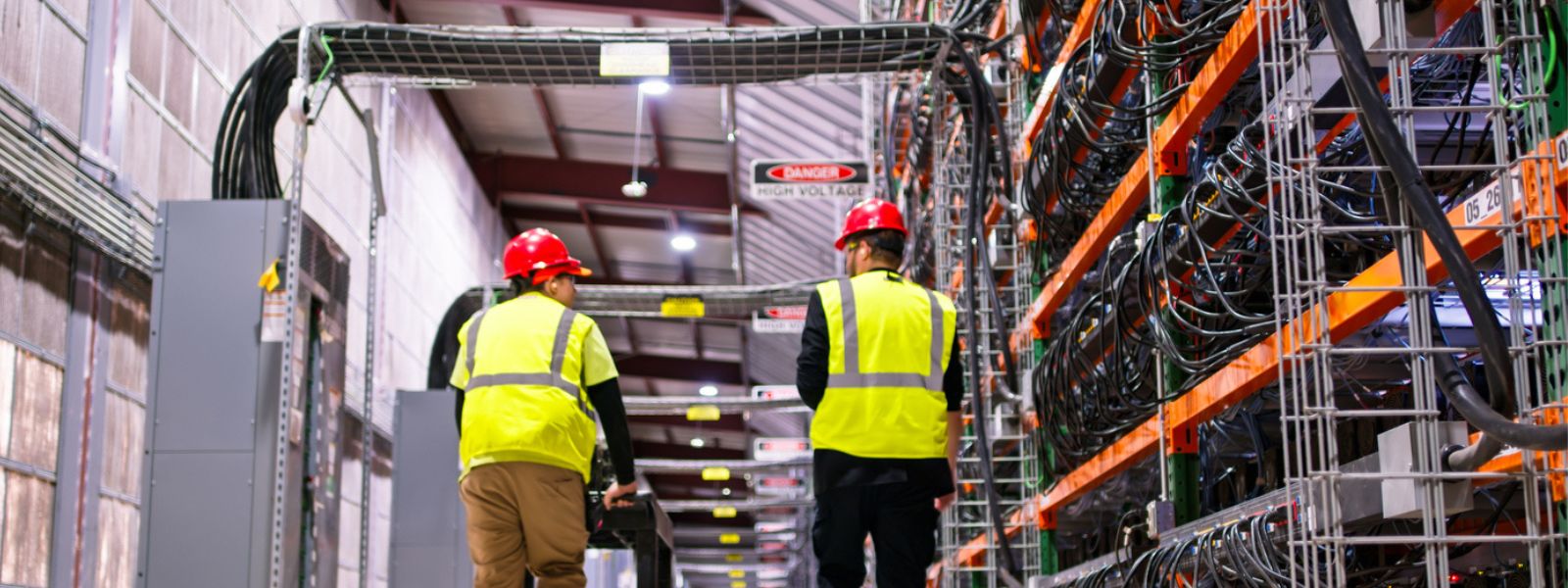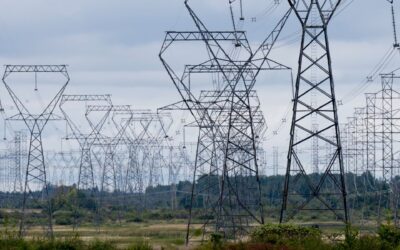Data centres are booming—thanks in large part to the rapid rise of artificial intelligence (AI)—and Canadian provinces are racing to attract them for both economic and security benefits.
But what are the links between data centres, greenhouse gas emissions and Canada’s clean energy future?
On the one hand, there are advantages. Building data centres can bring economic benefits, and clean electricity supply can help attract investment to do so, creating a virtuous loop. And new data centres could prompt further investments in infrastructure and accelerate the expansion of provincial electricity grids, enabling the bigger, cleaner, smarter electricity system necessary to decarbonize the Canadian economy.
On the other hand, electricity is increasingly scarce, and data centres are hungry for power now with uncertain future demand. Without care, new data centres could exacerbate concerns around electricity affordability and reliability, and create headwinds for decarbonization.
Overall, provincial policy choices are critically important for navigating these trade-offs and determining whether data centres can support decarbonization or hinder it.
Canadian governments are courting data centres, with electricity as a selling point
Let’s start by setting some context.
Data centres are not new to Canada, with 239 already operating across the country1. However, attention has recently surged around new, AI-focused data centres, which operate at a significantly larger scale than traditional facilities.
Canada’s federal and provincial governments have ramped up efforts to attract them, motivated by economic benefits, technological security, and data sovereignty. The potential capital investments are significant—in 2023, Google, Microsoft and Amazon’s investments in data centres were higher than that of the entire U.S. oil and gas industry—totalling around 0.5 per cent of U.S. GDP. And potential spillover benefits for other businesses include strengthened digital infrastructure and enhancement of local technology ecosystems.
Data centres need resources—including water, digital infrastructure, human capital, and technical expertise—but a primary operational requirement is electricity, particularly for cooling. Here Canada holds an energy efficiency advantage due to its cold climate that is compounded by its competitive advantage of cheap, reliable Canadian electricity, which is approximately 85 per cent renewable and non-emitting.
Provinces pursuing data centre investments have played to their electricity advantages.
For example, Crown utilities in B.C. and Quebec have also marketed themselves to data centres with their pitch centred on offering renewable electricity at some of the lowest prices in North America. In 2022, B.C. even offered temporary electricity rate discounts for data centres as an additional attractant, which was fully subscribed by 2023. Quebec’s earlier push attracted global technology giants Amazon Web Services, Google, Microsoft, and IBM to establish or expand large-scale data centre operations, however, the end of the energy surplus stopped further efforts.
Alberta is focusing its pitch to companies on available electricity supply in the near term as new gas plants and renewable projects reach completion, along with a deregulated electricity market that promises rapid supply expansion under favorable conditions.
Electricity use by data centres is rising rapidly — with less predictable future demand
Yet finding space on the grid is just as critical as securing power supply. New AI data centres require far more electricity in one place than traditional facilities. While traditional data centres typically draw 5 to 10 megawatts (MW) of electricity demand from modern AI facilities typically exceeds 100 MW—roughly equivalent to the annual consumption of 350,000 electric vehicles.
Even if power is available, these massive single-site loads can be difficult to integrate due to local grid constraints. As a result, finding a grid connection has become a growing challenge, with waitlists of up to seven years in hotspots such as Virginia’s data centre alley.
AI-driven data centres are more energy-intensive, which leads to higher electricity demand. Globally, the IEA estimates data centre energy consumption will double between 2022 and 2026. Canada’s data centre market is similarly expanding, projected to grow from its current 750 MW capacity to about 1.16 gigawatts (GW) by 2029.
Provincially, Ontario’s system operator sees data centres forming 13 per cent of new demand by 2035. Hydro Quebec has identified data centres as the largest new line item in its 2023 supply plan over the next 10 years. Meanwhile, as of March 2025, Alberta has over 10 GW of proposed data centre projects in the interconnection queue.
Though not all of these projects will materialize, electricity demand from data centres demand is going up. And determining the exact scale and timing of that rising demand curve is complicated.
For one, electricity infrastructure typically takes decades to plan and build. And while the demand for AI data centres is here now, the growth in data-centre electricity demand is highly uncertain beyond 2030.
That’s largely because the rate at which demand for AI services will grow over this timeframe, and the speed and scale of improvements in energy efficiency, are both unclear. The timing and magnitude of future efficiency improvements depend on technological improvements that will be difficult to predict.
The one thing we can say with confidence is that AI-driven data centres have added uncertainty to forecasts of future electricity demand and planning.
Meeting data centre demand could put pressure on electricity rates
What about affordability? Adding data centres can either help lower electricity prices for other consumers, or push them up for everyone. It all depends on how well the grid can handle their large, steady power demands, as well as how costs for any additional infrastructure are shared between customers.
In some cases, data centres can help keep costs per unit of electricity down or at least offset bigger increases. This has happened in places like California, where renewable energy is expanding and utilities are already upgrading infrastructure. In cases like that, data centres can actually bring down the per-unit cost of electricity. Their high, constant load helps cover the grid’s fixed expenses, spreading those costs over more total usage.
But in other jurisdictions with different grids, data centres could push prices up. Provinces like B.C. and Quebec rely on electricity supply from legacy hydro power systems that have been in place for decades. That means their system costs have largely been paid down and are humming along at a comparatively low cost. But with rising electricity demand from population growth and the accelerating energy transition, the surplus of supply has diminished. Adding new infrastructure to meet data centre demands means adding big new capital costs that have to be paid down over time. As that happens, the unit cost of electricity can increase and existing customers could end up paying more on their bills.
There are ways to protect customer rates. Some regions are finding ways to make sure large power users, like data centres, pay more of their share of the new infrastructure costs and take on more of the risk in case their demand changes in future. New pricing systems introduced in Indiana are one such example. Data centres could also help keep down system costs (and therefore rates) by offering some flexibility based on system demand. For example, Microsoft in Quebec agreed to reduce use by 30 per cent at peak time to help alleviate pressures on the grid.
Feeding data centres with fossil fuels will increase emissions
The race to build data centres, and to source power quickly, is also raising concerns about clean energy progress. In Alberta, if planned data centres go forward using gas power, the province’s electricity emissions would roughly double. That would effectively wipe out the emissions savings from the transition off coal-fired power in the province that has occurred in recent years. Similar concerns are emerging in places where the need for speed is leading to proposals to keep existing gas and coal plants running longer.
Renewables are still the cheapest and fastest-to-build sources of new power, but permitting and infrastructure challenges are slowing their expansion. Tech companies in the U.S. are already partnering with renewable energy providers to secure cleaner power, and similar efforts could be key in parts of Canada. Alberta for example, allows businesses to enter into power purchase agreements (PPAs) with private renewable generators. By entering into direct PPAs, data centres reduce their carbon footprint and hedge against price volatility, while renewable projects gain the financial security to invest in new capacity.
Provinces should enable smart choices on data centres and the energy transition
Whether these massive new data centres deliver net benefits or drawbacks depends on their broader economic impacts, whether they support the efficient use of existing electricity infrastructure or require new investment, and on competition from other potential uses for limited electricity infrastructure. And critically, it also depends on provincial policy choices.
Provinces face tough decisions about how to expand their electricity systems while balancing trade-offs. However, as it stands in almost all jurisdictions across Canada, grid operators do not allocate electricity supply to new customers according to relative costs and benefits. Without additional guidelines or frameworks, monopoly utilities must provide service to all customers who request it in their area, as long as it is safe and practical. To ensure fairness, customer applications are assessed on a first-come-first served basis.
Quebec is currently the only province with a government-led framework for prioritizing between new large customer connections. Interestingly, since that framework was adopted in 2023, no new data centres have made the cut.
Given all these factors and a rapidly evolving market for AI-based data centres, Canadian policymakers need clear policy frameworks that guide utilities through current decisions on competing industrial-scale demands, ensuring immediate choices align with broader objectives.
Equally crucial is the need for provinces to develop energy plans that provide longer-term roadmaps. These plans should consider and evaluate economic growth opportunities while setting guidance on electricity affordability, grid reliability, and emissions reductions. In doing so, they help decision-makers determine the desired pace and scale of future infrastructure expansion. Anything less risks higher rates, increased emissions, missed economic opportunities—or all of the above.
1 These are distributed as follows: Ontario (105), Quebec (57), B.C. (35) Alberta (22), other (20)








